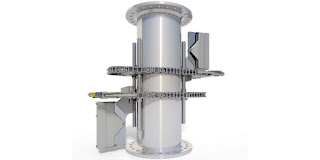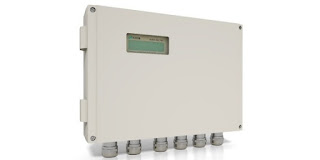 |
| One configuration of Flexim WaveInjector, allowing non-invasive flow measurement at extreme temperatures. Image courtesy Flexim Americas Corp. |
The Problem
Heat recovery steam generators were never designed for cyclic service. The move toward renewable energy resources (such as wind and photovoltaic), in tandem with the ability of the combined cycle plant to start-up and stop quickly, is expanding the role of the combined cycle plant as a backup source of power. With frequent starts/stops condensate management can be challenging. Draining the condensate is critically important for the safe and reliable operation of the boiler. While the problem of condensate drainage has been around for years, the problem is greater now in installations with a higher frequency of cycling. The importance of finding a good solution for detecting condensate in the HRSG drain lines is growing.
Boiler manufacturers address this situation through the use of condensate pots, level instruments, site glasses, and valves. None of these technologies provide a satisfactory combination of reliability, economy, and efficiency. Knowing when steam converts to water is difficult with this approach. Plus, over cautious systems sometimes release steam instead of condensate, wasting energy. A more reliable and consistent way to sense the presence of water in drain lines had to be found.
The Solution
By designing specialized mounting and tooling, modifying their sensing diagnostics, putting in hundreds of hours of field testing, and investing hundreds of hours improving their firmware for water detection, the manufacturer Flexim developed an ultrasonic flow meter that elegantly and reliably solves the HRSG drain line problem.
These clamp-on sensors work by measuring the transit-time difference of an ultrasonic signal, at varying flow velocities, through the process media. Ultrasonic, clamp-on flow meters have no moving parts, are not affected by density, and are mounted directly to the pipe in a non-invasive fashion.
The most challenging aspects of this application are the exposure of the sensing units to high temperature and the thick-walled pipes with small diameters commonly used for drains. To handle the high temperatures, specialized mounting and tooling were developed for the sensor allowing for pipe temperatures up to 750 deg. F. To overcome the small diameter / thick pipe issue, Flexim engineers reconfigured the sensor’s firmware to change from measuring flow rate, and instead measure noise (decibels) as an innovative way to distinguish steam from water.
Flexim’s unique ability to measure the presence of liquid in condensate drain pipes is a revolutionary development. This valuable solution helps customers run longer and safer, minimizing downtime. Share your measurement challenges with process measurement specialists, leveraging your own knowledge and experience with their product application expertise to develop an effective solution.


